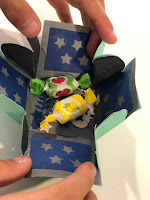CHRISTMAS TREE ELEPHANT TOOTHPASTE
The toothpaste demo is one of the most popular chemistry demos, in which a steaming tube of foam keeps erupting from its container, resembling a smooshed tube of elephant-sized toothpaste.
ELEPHANT TOOTHPASTE MATERIALS
- Erlenmeyer flask (If you don't have access to chemistry glassware, you can make a tree shape by inverting a funnel over a glass or making your own funnel using paper and tape (which you could decorate, if you like))
- 3% hydrogen peroxide solution (available at nearly any store)
- Packet of active yeast
- Liquid dishwashing detergent
- Warm water
- Green food colouring
MAKE ELEPHANT TOOTHPASTE
- Pour 1/2 cup hydrogen peroxide solution, 1/4 cup dish washing soap, and a few drops of food colouring into the bottle.
- Swish the bottle around to mix the ingredients. Set the bottle in a sink or outdoors or some other place where you won't mind getting wet foam everywhere.
- In a separate container, mix a packet of active yeast with a little warm water. Give the yeast about 5 minutes to activate before proceeding to the next step.
- When you are ready to do the demo, pour the yeast mixture into the bottle.
HOW IT WORKS
Hydrogen peroxide (H2O2) is a reactive molecule that readily decomposes into water (H2O) and oxygen:
2H2O2 → 2H2O + O2(g)
2H2O2 → 2H2O + O2(g)
In this demonstration, yeast catalyzes the decomposition so that it proceeds much more rapidly than normal.
Yeast need warm water in order to reproduce, so the reaction won't work as well if you use cold water (no reaction) or very hot water (which kills the yeast). The dish washing detergent captures the oxygen that is released, making foam. Food colouring can colour the film of the bubbles so that you get coloured foam.
In addition to being a nice example of a decomposition reaction and a catalyzed reaction, the elephant toothpaste demo is exothermic, so heat is produced. However, the reaction just makes the solution warmer, not hot enough to cause burns.
COMPARING THE ORIGINAL REACTION WITH THE KID-FRIENDLY RECIPE
The original elephant toothpaste reaction, which uses a much higher concentration of hydrogen peroxide, can cause both chemical burns and thermal burns. While it produces a larger amount of foam, it's not safe for kids and should only be performed by an adult using proper safety gear. From a chemistry perspective, both reactions are similar, except the kid-safe version is catalyzed by yeast, while the original demonstration is usually catalyzed using potassium iodide (KI).

Comments
Post a Comment